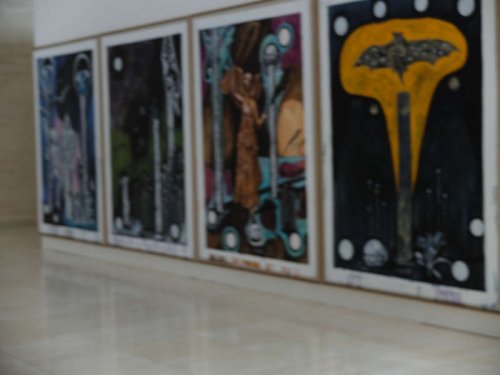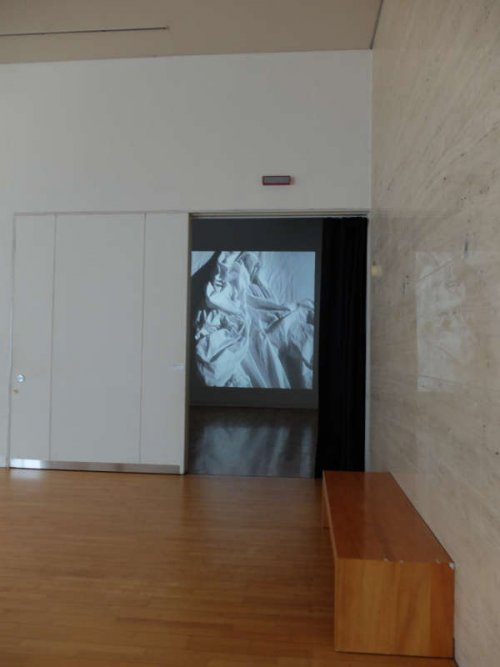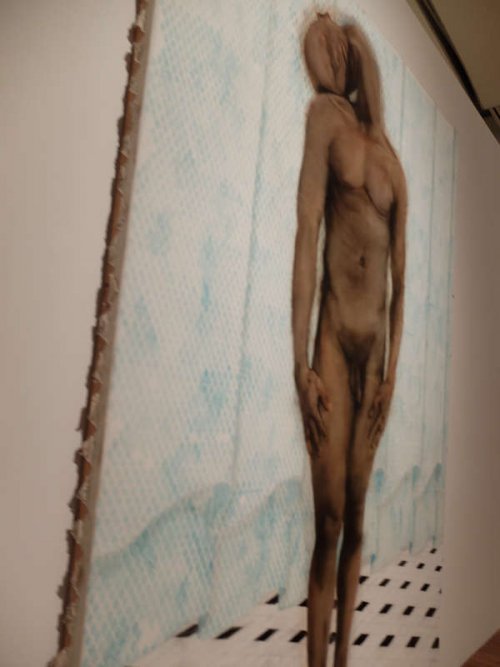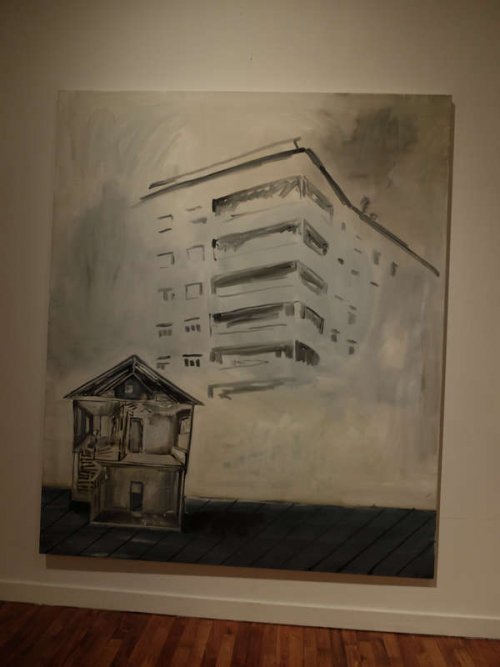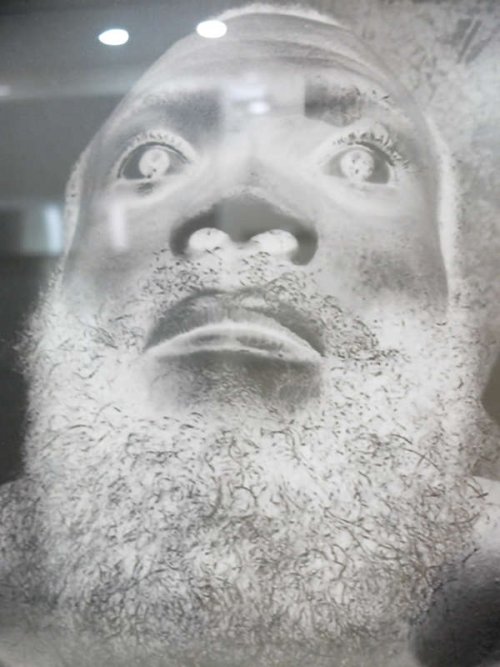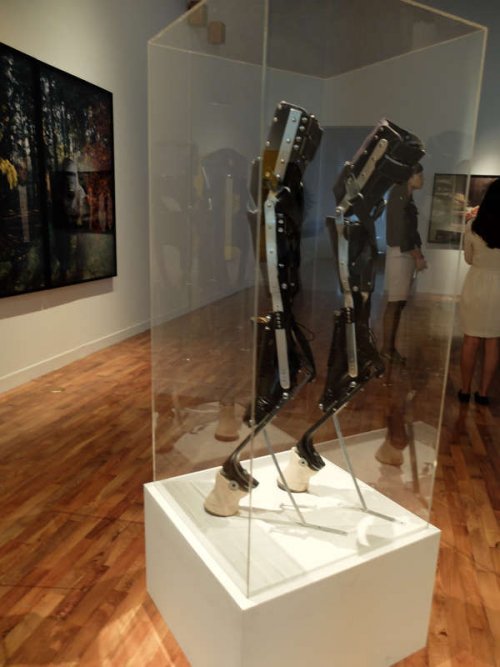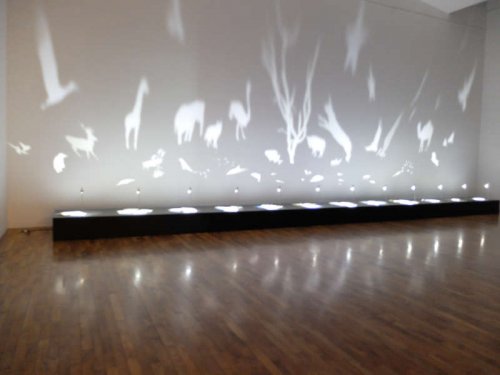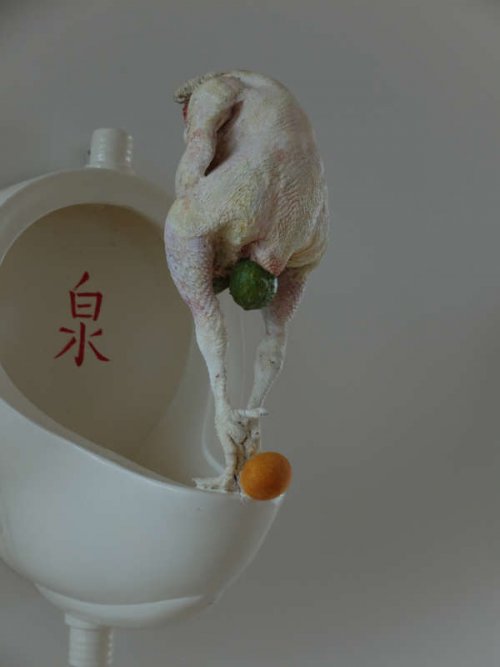
Accueil > Les rubriques > Appareil > Société > Biennals
Biennals
Quelques remarques sur notre relation au monde
,
Toutes les versions de cet article : [English] [français]
Korea 2014 : two cities, Gwangju and Busan, two biennals and two titles, each title as the other side of the other. In Gwangju, the title is : "Burning down the house". In Busan, the title is "Inhabiting the world".
In Gwandju, the suggestion is to burn down the place where we are supposed to live so as to clear a space enabling thought and creation to unfold, the act of destruction being the prelude to a renewal. The world is assumed to be inhospitable and the house, i.e. the place of everyday life and safety, has to be sacrificed in order to get back to the world, consequently as a supposedly liveable place. But what world is it about ? The biennal doesn’t tell otherwise than assuming it can be saved ( what from ? destruction ?) and "we" can be saved, at least through art.
"Burning down the house" examines this potential of art as movement by exploring the efforts made by contemporary artists to address personal and public issues through individual and collective engagement, as well as demonstrating how challenging these efforts and their impact have become » writes Jessica Morgan in her introduction in the catalog.
In Busan the world is assumed to be reassuring enough to be still possibly liveable. We skip the destruction phase, and bring out the positive forms which made it liveable and, because they are still active, continue to make it a liveable place. Those ’figures’ displayed as so many windows open onto the worlds have names : movement, the cosmos and the sky, architecture and object’s mobility, identities represented, history and war, animal’s dialogue, nature and witness.
In both cases the belief in a modernist project is maintained. This faith is meant to stem from some igneous catharsis in one case and emerge from a synthetic, positive and sensible reading of the figures which make up the world in the second. It has to be assumed that our faith in the world is widely jeopardised by the state of the world, but this is never spelt out, and this endangered faith could, we are told, rise up from the ashes if it accepts to fling itself into the fire, or reappear younger looking if it accepts plastic surgery.
Crisis and expectation
The issue at stake, both for artists and critics, is to know where one should stand to create and what is important to create today.
There is indeed nothing obvious about this. For two main reasons : the first being that we are living in a world said to be globalised whose order can only be perceived with difficulty and, at any rate, no longer matches the pattern inherited from modernity. The second reason being that we have really lost our bearings. In order to comfort ourselves and in the hope of finding some form of direction or other, we are both constantly in search of roots, looking toward the past and lifted by the hope that something new, a miracle maybe, might help us to do so and then we are looking toward the future.
This situation, therefore this disorientation, is not without impacting the minds of each one of us and those of artists in particular.
This disorientation feels uncomfortable. It is the current form of the crisis. In that crisis, no one can assert they are living in a single world any more. Each one has to admit they are living in at least two and actually several. Which enables us to state that our actual situation is being permanently "in between".
Crisis, as opposed to what one may think, is a positive word, provided you understand it as defined by the great media philosopher, Vilèm Flusser. In the chapter entitled "Moon" from his book "Essays on nature and culture" he brings up the fact that the moon has become a satellite belonging to NASA whereas we still see in it "a natural satellite of the earth" : my vision doesn’t take my knowledge into account. This lack of reckoning of knowledge in our vision is a feature of certain situations called "crises"."(quoted work. p 62). This remark is very useful to us in so far as it points to the challenge which confronts both thinking and art, and beyond, all creative processes, which is. to implement, restore or transform the links and connections between knowledge and worldvision. What is being referred to here are the connections between the data provided by hard sciences such as human sciences and the acceptable representation of an equally acceptable world that we are trying to form. And the difficulty lies in the fact that the world we are living in is not only tough, violent, unsteady but also hard to embrace with a single gaze.
This tension leads us to understand that those obvious things are but old beliefs. We might also call them stereotypes, rooted in us by the particular use we make of language, or we might say languages.
Art is but an individual or collective attempt to understand what is occurring by projecting on to the world what pertains for each to their knowledge and need for direction, and thus art finds itself in a new position. Its primary purpose is no longer to link a plastic, literary or musical proposal to feelings and go from the psycho-emotional field towards beauty or even truth or towards the intellectual field.
Art is nowadays entirely devoted to this demanding yet lofty task of translating what is little or ill-known into a more familiar vocabulary, or, if you will, to lead the familiar forms of language or expression to some renewal so as to be able to face that upcoming unknown.
One could mention the major visionary anticipation work by Nam June Paik and more particularly "Moon is the oldest TV".
This image of the moon is actually a lit up surface. It is easy to see some hardly metaphorical connection to a projection. The surface of the moon immerses us into some expectation of an image which would be projected over a kind of screen suspended in the infinite darkness of the sky, like in a huge cinema hall. For Paik, the Moon is thus the "oldest TV". The Moon has always been there, or nearly. However we also know that Paik goes further in his refusal of the different features attached to the medium TV - live broadcasting, recording, rerun, permanent flow of all kinds of images - since the so-called phases of the moon do not actually exist. The forms we take for moon crescents have actually been obtained by placing magnets on the cathode-ray tube. The image of the moon is generated by our association process, our infering system. The image on the screen is clearly born from our imagination, even though it is based on a phenomenon linked to the medium TV. Television then becomes the transcription into our world of an original shape which existed long before man could look at it as a natural phenomenon, an image or as a NASA satellite.
We should call forth, as an echo, Jean-Luc Godard’s latest film, whose title is in itself a very ambitious yet very ambiguous scheme, "Farewell to language".He is indeed pointing to the obstacles, unyielding areas, frictional areas between words and images, which can sometimes be spotted in the shape of tiny black holes or unexpected electric flashes of lightning.
For the main thing or one of the main things at stake, never questioned by either of these biennals, is the status, the purpose and the impact of images, which have become paramount, on our way of thinking and our psyche. The real question is therefore to know whether inhabiting the world is no longer spelt out along the modernist belief in the rescuing power of art and language, but under the split, radical, smooth and elusive form, born by images, by the flow of images which, at the same time, undoes our ancient world, resets our perception and establishes a new world.
Inhabiting the world implies a conscience which figures it out and makes it a liveable place. Now that conscience is obsolete. A new way of thinking is emerging. Inhabiting the world is both trying to describe it and thus endeavouring to draw a part of the new map of the world.
Split and disinhibition
In a text which has remained famous, "Rules for the human park", Peter Sloterdijk has defined our situation in a simple way : "Two and a half thousand years after the time when Plato wrote, it looks as if both the gods and the wise have withdrawn, leaving us alone with our ignorance and half knowledge on everything". This is both precise and vague. What is truly at stake is grasping our existential situation using the most recent elements of our knowledge. And it paradoxically brings us also back to our prehistory. Sloterdijk indeed remarks in this text that "one might go as far as to label man as the creature whose animal-being and animal-remaining has failed. By failing as animal, the undecided being stumbles out of the surrounding world and in this way acquires the world in an ontological sense."
However, this ontological acquisition is not without having a few surprises in store. The main one being that, whatever our culture and any belief in allmighty modernity finally "absorbed", we have to agree to face our situation which is the following :"In modern culture too the titanic fight occurs between those impulses that tame and those that bestialize, together with their respective media".
And this division has been implemented and activated today by images, technically, ontologically and psychologically.
In fact, we inhabit the world "through" what enables us to perceive a dominant media. If we did so in the past through words and stories, and our modernist faith is based on them, we mainly do so nowadays through images. This new deal, this new medium and its impact is what we have to take into account.
This medium draws an area of conflict between those impulses that tame and those that bestialise, determines the terms of the fracture, for words have not disappeared but their status has changed. So has the shape of the crisis, that split running through our brain, and dividing it further more, which sends us back to a state ressembling, to a certain extent, that which was ours before writing was invented.
The split is to be understood in a positive way, freed from any psychiatric meaning. The split is the state of our brain today, the state of our divided thought, in the same way as the world is divided. We therefore need to invent a new way of conceiving and pondering over what is happening and what is happening to us. The split is both a source of tension and the central form of invention.
Critique has to take charge of the crisis as a manifestation of the split, and as for art, it has to take charge of the split as an expression of the crisis. Art multiplies the lines of split while critique spots them and tries to give them if not some order, at least a shape, a figure, a readability hinging affects on percepts.
This positive approach of the split leads us to understand that it manifests itself both as a deep fracture between two irreconciliable worlds and as a network of cracks. The split doesn’t grow, it multiplies. In other words the split is the hallmark of the double and the multiple in a world that some persist in considering as "monotheistic".
Images and psychological mutation
Mediums don’t annul one another, they grow in number, pile up, move inside the strata, slither between them, come undone, reconstruct themselves, change, mutate, and drag us into their mutations as the authors, the receptors and "functionaries" in the meaning given to the term by Vilèm Flusser.
There is what is ancient, what looks new, what comes back and retroactively works on what is present, what has been given up, what resurfaces out of a distant past. Yes, the situation is indeed complex. Thinking is plunging into complexity. At any rate, it is forbidding oneself to resort to oversimplifications for the simple reason that complexity would be too complex and therefore unthinkable. But it is also knowing how to grasp complexity through efficient syntheses. Otherwise, as it generally is the case, we are satisfied with replaying the same old songs, songs about the being, the subject, the world, reason, images, words, the same old songs that lay a thin coat of paint on the walls but leave the way the displayed elements are organised or staged totally untouched.
Let’s focus one minute on the word image, on the thing images, on the complexity comprised in the word and the thing, to use the language of the past century, which blows up in our faces and scares us.
There are at least six types of images, not all pertaining to the same field, to the same stratum. For instance, images in the days of Plato are not the same as today’s. But it can’t be denied that, seen from a certain angle, they are an extention of them and yet differ fundamentally.
So, six types of images, concrete images. For there is also the subject of mental images that we will not broach here.
1. There are images which are related to the stroke, the shadow, the first drawing, skiagraphia, handwork, painting. They tell, for us, about the gap between a model, absolute yet absent, and an inscription which has inevitably deteriorated when compared to the model as it has been through the medium of the body and the matter.
2. Then come the christian images, born from symbols and escorting the words. They are the secret core of the promise, the secret weapon of the divine economy, indeed enabling the return, after death, to an image turned back into light.
3. Then come technical images, a perfect mix of the first two, but going further and leading them elsewhere thanks to the addition of chemistry. They are called photographs. They open up a new register to speech but keep bumping on the invisible text which bears them.
4. Then come the pictures set into motion so as to retain the lesson of history. These are still borne by the power of language. It is cinema.
5. Then come video images enabling one to be part of what is going on and therefore to become, actors. But those actors quickly turn out to be actual ghosts, or at least doubles of themselves, the antics of whom they are watching on the screen of their television set.
6. Finally come computer and cell phone images which are not just video images. Indeed, they play a whole new role, in so far as they essentially enable us to find our way around in a reality which have become too complex, too manifold to be grasped by a single individual, however free and aware they may claim to be. The purpose of these images is thus to find our way around, i.e. to find ourselves in the chaotic cacophony of the world and therefore, in other words, inhabit it. But these images also keep within themselves some aspects and some functions of the images of the previous levels, which they keep reorganising at the same time, on which they unceasingly retroactively work, the status and the function of which they alter in us and for us.
And here is, in a few words, how we inhabit the world today, around the question of images. They are still deteriorated versions of some inaccessible model. They still keep alive some of the promise of a resurrection. They still show us fragments of beauty, things that have been seen and set motionless for us and laid down for us to contemplate. They call back to existence some inanimate beings, happy to retrieve language, but scared of movement and which are, as images, perceived as active, efficient and real images we identify with. We are gradually learning that there is no fundamental difference between those ghosts and us, that we are both "one" and "the other".
But what those images mostly do is question the ontological status of ancient images as their main impact is to go through everything and cut it in halves. divide our perception in two, slice through our brain to the extent of giving us two back. How come ? Because those images have become the judges who tell everyone of us, every minute, what is allowed and therefore, which impulses can tame what has not been allowed yet and which impulses bestialise.They divide our brain in two and so do they our living body, since it can’t live without its double which has become visible every minute and is everywhere present in those images of it or which tell about it because they are talking to it.
So what ?
So what ? We were just wondering what "inhabiting the world" or "burning down the house" could mean ? What we notice is that it may not be the right question, at any rate not the most important, the most topical, the most urgent.
It is not the right question in so far as it tells nothing of what we have become, what we have turned into, how it has made our worldvision mutate. This mutation is due to the fact that we both live here, in what we persist in seeing as the only real world and elsewhere. That elsewhere is the world created by the countless quantity of images we have to resort to to find our way around in this world we believe to be real and unique, and which has become manifold.
It is true that we have invented those worlds. And thus images do not only help us to find our way around in "this" world but to live "between"one and the other. And it is in this invisible in-between that we are for the moment often a bit lost.
That is why we have to go through the stage of inhibiting and disinhibiting injunctions again and go back that prehistory of man. But we are doing so this time with extremely sophisticated navigation devices. Without learning how to use them, including unlearning how to read, which is but a side effect, we won’t be able to go anywhere. We would then lose both ourselves and the world.
Words have been demonetized even though we still use them. Images have "unontologized" existence. Without "money" and without "being", we are engulfed in the flames which have invaded the house, that of our thinking-body. But we can’t leave it as this still means dying. In order to live, we have to accept to be "facing" ourselves, "out of" ourselves rather than "inside ourselves".
This double externality has become our dwelling place and we have to know and desire, learn and manage to "inhabit" it.
Traduction Christine Lenormand
Cette conférence a été prononcée dans le cadre du Forum du 15 octobre 2014, événement de la biennale de Busan.

